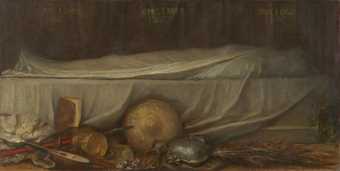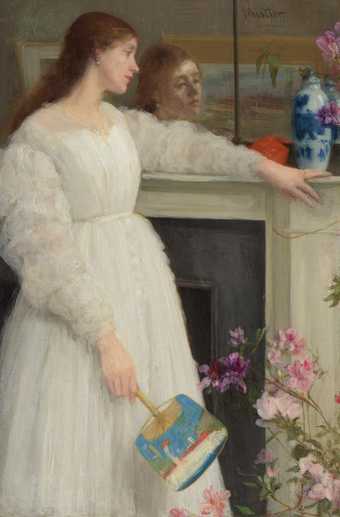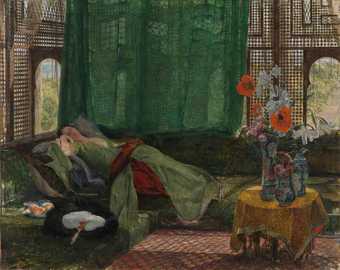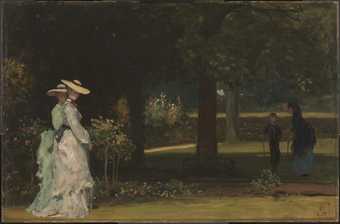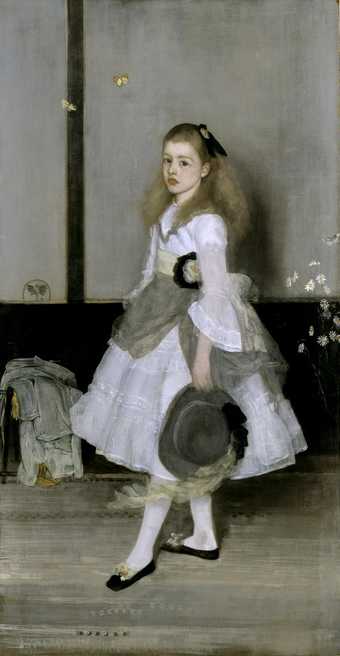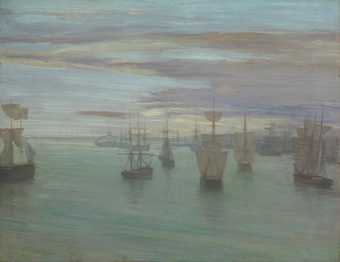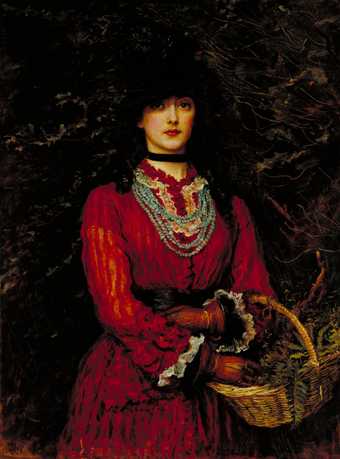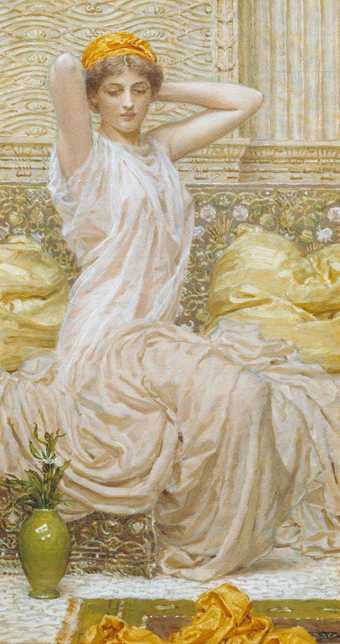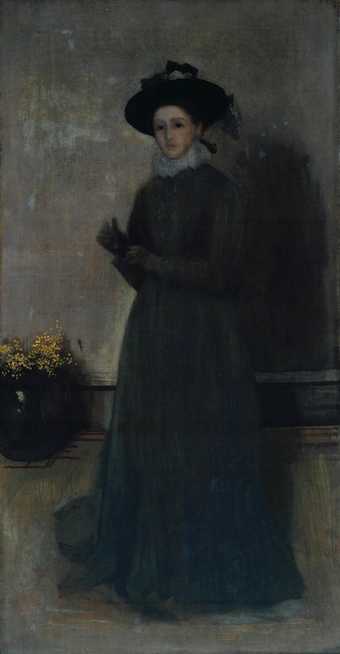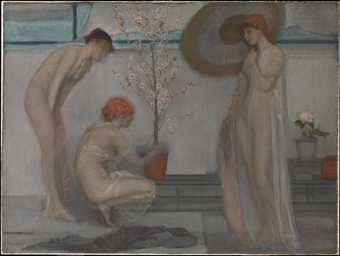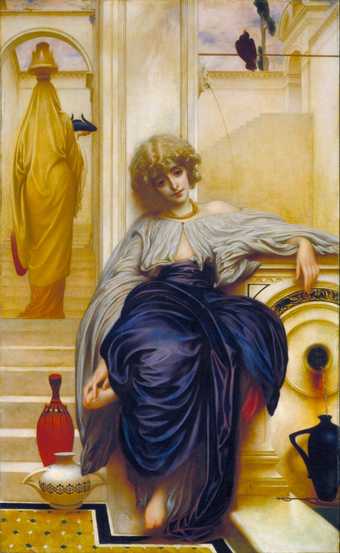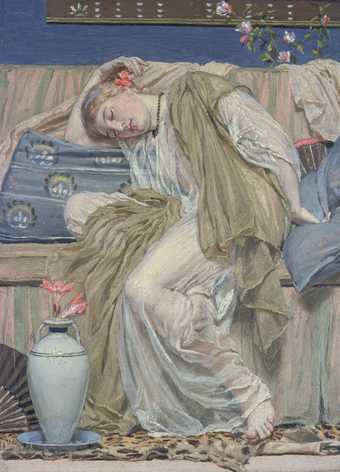
In Tate Britain
- Artist
- Albert Moore 1841–1893
- Medium
- Oil paint on canvas
- Dimensions
- Support: 1746 × 879 mm
frame: 1980 × 1110 × 95 mm - Collection
- Tate
- Acquisition
- Purchased with assistance from the Friends of the Tate Gallery 1980
- Reference
- T03064
Display caption
Moore, like many of his contemporaries, was influenced by Japanese art. He produced decorative and subtly coloured pictures. Here, the woman’s costume allows him to concentrate on the colour, texture and movement of draped fabric. Art critic Sidney Colvin said Moore’s subjects were ‘merely a mechanism for getting beautiful people into beautiful situations’. The flower-like symbol at the bottom of the picture was used by Moore as a signature.
Gallery label, August 2018
Does this text contain inaccurate information or language that you feel we should improve or change? We would like to hear from you.
Catalogue entry
T03064 A GARDEN 1869
Inscribed with Moore's anthemion device and the date ‘1869’ bottom left; inscribed on the stretcher ‘No 1/A GARDEN/A. Moore/3 Red Lion Square. W.C.’
Oil on canvas, 68 3/4 × 34 5/8 (174.5 × 88)
Purchased from Fischer Fine Art Ltd (Grant-in-Aid) with assistance from the Friends of the Tate Gallery 1980
Prov: ...; Alexander Henderson (later Baron Faringdon) by 1894 and sold by his executors, Sotheby's 13 June 1934 (123), bt Collings (£12); ...; acquired c.1970 from Jarl Johansson, Hälsingborg, Sweden by Vagn Laursen, Snekkersten, Denmark and from him, c.1971, by Steffen Irmang, sold Sotheby's Belgravia, 1 October 1979 (42, repr.in colour), bt Fischer Fine Art Ltd.
Exh: R.A. 1870 (966, ‘A garden’).
Lit: Alfred Lys Baldry, Albert Moore, 1894, pp.39–40, repr.facing p.20 as in the collection of Alexander Henderson.
'A Garden’ is one of Moore's earliest canvases of single, standing female figures in classical drapery, the first being ‘Azaleas’ which he exhibited in 1868 (Hugh Lane Municipal Gallery of Modern Art, Dublin; exh. Victorian High Renaissance, Manchester, Minneapolis and Brooklyn 1978–9, no.72, repr.). Other pictures in this vein are the smaller ‘Shuttlecock’ (Private Coll.; ibid., no.74, repr.) and ‘Battledore’ (Coll. Paul Johnson) of 1869–70 and such later works as ‘Blossoms’ of 1881 (Tate Gallery, N01549). Although depicting a nude figure, the ‘Venus’ of 1869 (York City Art Gallery; exh. Victorian High Renaissance, no.73, repr.) is also formally related to ‘A Garden’. In all these works Moore depicts a full-length figure standing in a shallow space which is closed by a high wall, screen or background curtain. A rectangle of paving or carpet at the bottom of the picture (often cut by the picture edge) helps to define this space but, because of the steep recession of its lines, also emphasises the picture surface. Pale colours and low-relief modelling serve the same end.
Moore's interest in painting these decorative canvases of full-length classical figures was probably stimulated by two mural schemes which he executed at Claremont in 1867 and the Queen's Theatre, Long Acre in 1868, the latter comprising a tempera frieze of life-size classical figures over the proscenium arch. He was also on friendly terms with Whistler at this time. While the latter adopted Moore's use of classical draperies, Moore took up Whistler's interest in Japanese prints. The pattern-making and soft colours of ‘A Garden’ can be partly attributed to this Japonisme.
Moore's intentions in the late 1860s appear to have been accurately summed up by Sidney Colvin who, writing in The Portfolio in 1870 (p.5), described Moore's ‘habit, right or wrong, of making the decorative aspect of his canvas, regarded as an arrangement of beautiful lines and refreshing colours, the one important matter in his work. The subject, whatever subject is chosen, is merely a mechanism for getting beautiful people into beautiful situations’. Some critics, however, had difficulty in making sense of Moore. Reviewing ‘A Garden’ when it was exhibited at the Royal Academy in 1870, a writer in The Art-Journal (1870, p.171) found it ‘an anomaly, and perhaps an anachronism; in style it has no precise place in time or space: its nearest belongings would seem to be among the mural paintings of Pompeii; and yet the figure is so flat that the manner is rather that of a bas-relief than of a picture. In colour the artist has an unaccountable liking for washed-out greens and feeble, faded tones generally’.
Two cartoons for ‘A Garden’ are in the Victoria and Albert Museum: no. D251–1905, charcoal and white chalk on brown paper, 46 1/2 × 23 1/2in. (exh. Albert Moore and his Contemporaries, Laing Art Gallery, Newcastle 1972, no.28), showing the figure lightly draped but lacking the extremities of the limbs (either because the paper was too small originally or was later cut down), and no.250–1905, charcoal on brown paper, 62 × 34in., not available for inspection in 1982 but said to show the figure nude and to be pricked for transfer to the canvas.
A small drawing of the composition is in the Hunterian Art Gallery, University of Glasgow: black and white chalk on brown paper, 11 13/16 × 7in.; the figure is draped and a vase and a bowl are indicated at the bottom right, instead of the basket seen in the painting.
Moore moved to 3 Red Lion Square, the address given on the stretcher of ‘A Garden’, in 1869. The painter R.B. Martineau had formerly worked there.
Published in:
The Tate Gallery 1980-82: Illustrated Catalogue of Acquisitions, London 1984
Explore
- architecture(30,960)
-
- garden structures(1,939)
- townscapes / man-made features(21,603)
-
- wall(626)
- recreational activities(2,836)
-
- picking flowers(28)
- clothing and personal items(5,879)
-
- drapery(122)
- basket(484)
- actions: postures and motions(9,111)
-
- arm / arms raised(839)
- woman(9,110)
You might like
-
Albert Moore Blossoms
1881 -
Marcus Stone Il y en a toujours un autre
1882 -
George Frederic Watts Sic Transit
1891–2 -
James Abbott McNeill Whistler Symphony in White, No. 2: The Little White Girl
1864 -
James Abbott McNeill Whistler Nocturne: Black and Gold - The Fire Wheel
1875 -
John Frederick Lewis The Siesta
1876 -
James Sant Miss Martineau’s Garden
1873 -
James Abbott McNeill Whistler Harmony in Grey and Green: Miss Cicely Alexander
1872–4 -
James Abbott McNeill Whistler Crepuscule in Flesh Colour and Green: Valparaiso
1866 -
Sir John Everett Millais, Bt Miss Eveleen Tennant
1874 -
Albert Moore The Toilette
1886 -
James Abbott McNeill Whistler Miss Agnes Mary Alexander
c.1873 -
James Abbott McNeill Whistler Three Figures: Pink and Grey
1868–78 -
Frederic, Lord Leighton Lieder ohne Worte
exhibited 1861 -
Albert Moore A Sleeping Girl
c.1875



